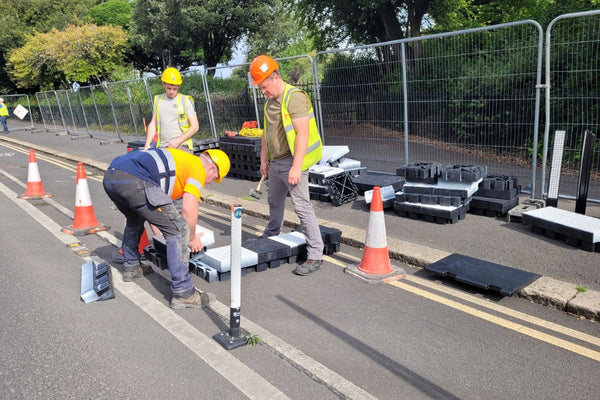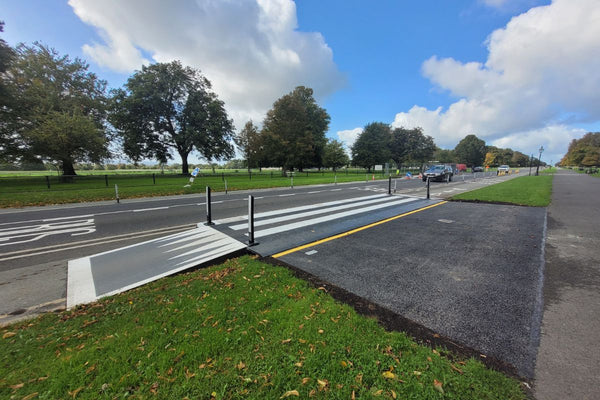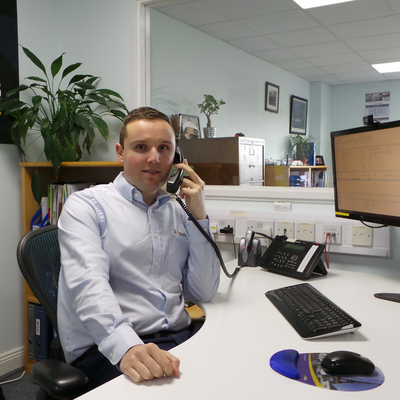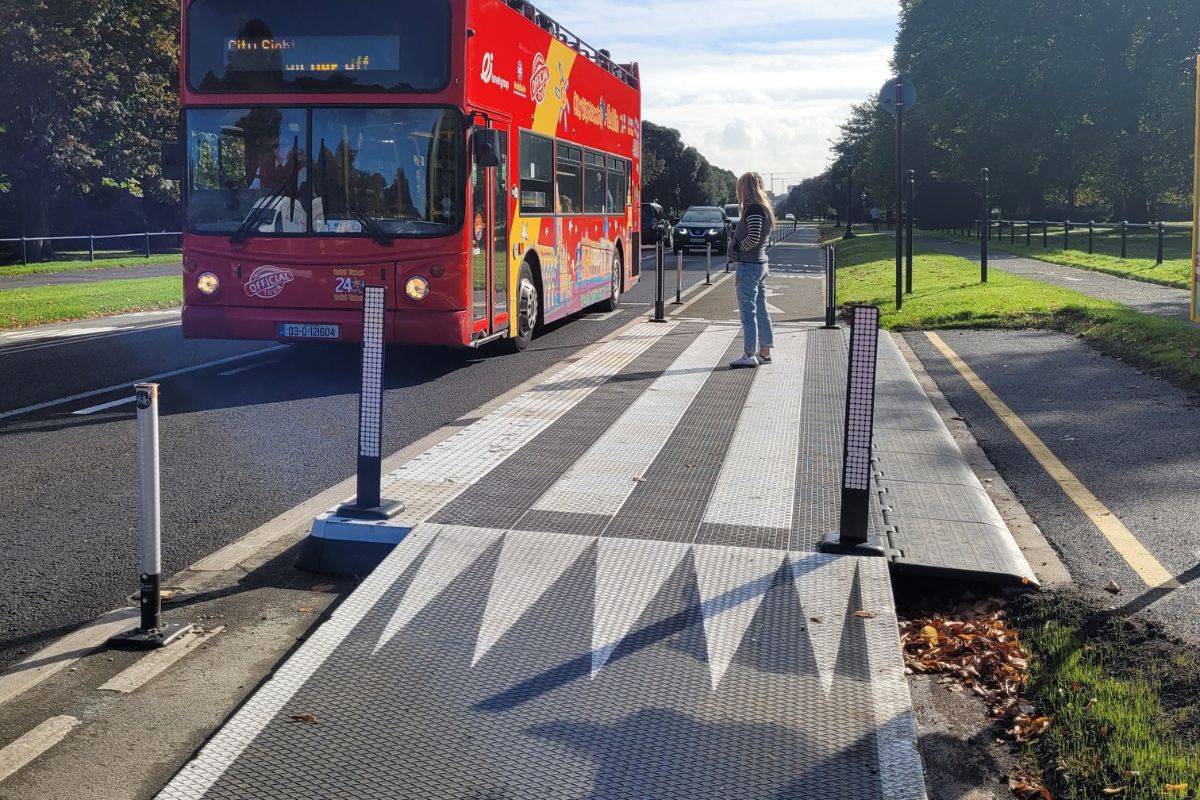In 2023, the Office of Public Works began work on a project that would completely transform the streetscape surrounding Phoenix Park in Dublin. The much sought-after project would connect Phoenix Park, Europe's largest enclosed park, with the current Dublin Bus network. The project coincided with the launch of the first-ever public bus service to Phoenix Park, Route 99, which officially began operating on October 8th 2023. The route aimed to provide better access to the popular visitor attractions in the area, with bus stops installed at Dublin Zoo, the Phoenix Park visitor centre, and the Phoenix Monument for those visiting Áras an Uachtaráin.
The project aimed to improve accessibility to these local attractions and provide better, more frequent public transport to encourage more use in this area. This would also reduce private car use and, therefore, reduce emissions in the long term, which falls in line with government expectations to boost sustainability and reduce carbon emissions by 2030.
While the new bus stops would be needed as part of the new route, the previous infrastructure only allowed them to be installed while hindering local traffic, cycle routes, and pedestrian safety. To create these bus stops, the OPW had to come up with a solution that would keep bus users, pedestrians, cyclists, and motorists happy while, first and foremost, delivering a reliable and efficient bus network to commuters.

The challenges
Phoenix Park streetscape: The previous streetscape design around the Phoenix Park area meant that installing bus stops would eventually prove problematic for all concerned. Narrow road sections with little vehicle room and on-street parking on both sides (e.g. North Road) would require specific bus stop setups instead of the standard designs that work in other areas.
Cycle lane and bus stop conflict: The current setup of cycle lanes in the area also meant that the bus stops and cycle lanes would need to run side by side without hindering each other. Standard bus stop installations would interfere with cycle lanes and put cyclists in further danger of collision.
Bus passenger safety: The on-street parking on North Road at Dublin Zoo, in particular, reduced the space that buses require to pick up passengers. Parking on both sides of the road limited the space further and would leave little room for buses to stop. Even if bus stops were installed in empty areas between car parking spaces, passengers would still have to step onto the road to get on or off the bus, increasing the risk of an accident for bus passengers and motorists.
Time constraints: The Office of Public Works mentioned from the outset that any and all works carried out would need to be done as quickly as possible. The previously mentioned space constraints around Phoenix Park would mean that road closures needed to be kept to a minimum as it would prove to be a busy route.
Interference with heritage infrastructure: it was also clear that any recommended solution could not interfere with the pre-existing kerbing deemed part of local Dublin heritage. This would rule out any concrete infrastructure and extensive civils attached to the current kerbs, as any permanent structure would damage the kerbing.

The solution
Several site visits with the Office of Public Works made the solution to Route 99 more evident. It became clear that there was a solution that would benefit all parties that would
- Allow for a quick install time to reduce downtime on the local roads
- Minimise interference with local Dublin heritage infrastructure
- Provide better bus passenger safety when embarking or disembarking on buses on Route 99
- Suit the narrow streetscape around the Phoenix Park area, including North Road where Dublin Zoo is located
- Solve the conflict between bus stops and cycle lanes
The Vectorial® System by ZICLA
Pittman® suggested the unique design of the Vectorial® System to the OPW. The modular design of the Vectorial® meant that it could cater to the exact design requirement of Route 99.
Modular design: The Vectorial® System's modular design allows a single bus platform to be assembled piece-by-piece very quickly, especially compared to concrete kerbs or footpaths. The fast installation would minimise vehicle traffic downtime on Route 99 and allow for a sooner project finish date. The modular design also means parts can be easily removed or replace if needed.
Increased bus passenger safety: the Vectorial® system can be fully customised to the size required, meaning it can be as long or as wide as it needs to be on site. The platform can be installed next to current kerbs to extend it and meet Dublin Bus doors for safer embarking and disembarking.
Protects Dublin heritage infrastructure: because the Vectorial® system is modular it does not rely on current infrastructure for physical support. The platforms can be installed next to current kerbs and will utilise a hinged platform system that would sit on top of current kerbs, without the need for costly civils.
Solves the conflict between the cycle lanes and bus stops on Route 99: One of the key features of the Vectorial® system is that it can allow cycle lanes and bus stops to exist simultaneously in the same area. The proposed design for Route 99 would include ramp systems at either end of the platform that allow cycle lanes to continue up and over the platform, ensuring that cyclists and bus passengers could co-exist without hindering the other.

Results
Following advice from our team, the Office of Public Works proceeded with the installation of 6 no. Vectorial® system bus platforms around route 99. All platforms were installed and operational on the launch day, 8th October 2023.
Dublin bus passengers and drivers' positive reaction: The Vectorial® system was praised for making it much safer for bus passengers to enter or leave a bus. Bus drivers also praised it for making picking up passengers on Route 99 easier than on other city routes.
Positive feedback from cyclists: Cyclists praised the platform format and said it did not affect local cycle lanes. The addition of reflective bollards with the Vectorial® systems further delineated cycle lanes, making them safer regarding vehicle traffic and offering better protection to cyclists.
Met project deadlines: The Office of Public Works and contractors praised the modular design of the Vectorial® and how it allowed for a fast project completion time, minimal interruption to traffic and reduced civil engineering on site.
Dublin heritage infrastructure protected: it was confirmed that all platforms were installed without interfering with local Dublin heritage infrastructure, as requested by the OPW. All installations were quickly completed, and all original streetscapes were confirmed to be in their original state after installation.
Boost to local amenities and attractions: The project has helped to create safer, more efficient bus stops for this new route. The route has been praised for bridging the gap between the Phoenix Park area and the rest of Dublin City, boosting local amenities and tourist attractions.







